Disability leave policy - NASUWT
Disability leave policy - NASUWT
Disability leave policy - NASUWT
You also want an ePaper? Increase the reach of your titles
YUMPU automatically turns print PDFs into web optimized ePapers that Google loves.
Sickness and disabilityThe Equality Act 2010 defines a person with a disability as a person with a physical or mental impairment, which has asubstantial and long-term adverse effect on their ability to carry out normal day-to-day activities. Under the Equality Act2010, employers have a duty to make ‘reasonable adjustments’ where any aspect of working arrangements (includingpremises) places a person with a disability at a substantial disadvantage.ConfidentialityInformation about an individual’s disability or impairment should be handled in a sensitive and confidential manner by allparties. The Data Protection Act 1998 and the Access to Medical Reports Act 1988 provide protections to individuals inthis respect. All sensitive and confidential information on an employee should be stored in a safe and secure environment.The disclosure of confidential information in the employment context is also protected by the implied duty of trust andconfidence owed by an employer to an employee.Although an employer need not know of an employee’s disability in order to subject the person to discrimination, a‘knowledge’ of disability is an essential requirement for reasonable adjustments to apply.Time off to attend medical appointmentsSome employers may wish to insert an amendment to the effect that employees should try to ensure that non-urgentmedical appointments or appointments not relating to their disability take place in their own time. Such an amendmentwould be acceptable, but only where there is an agreement to add to the <strong>policy</strong> that this may not be possible in allcircumstances – for example, hospital appointments and treatments.Medical appointments may already be covered in a separate <strong>leave</strong> <strong>policy</strong>, particularly if it is a medical emergency, or as anauthorised absence with or without pay. This <strong>policy</strong> should be consistent with the <strong>leave</strong> <strong>policy</strong> and that <strong>policy</strong> may need tobe amended if it fails to comply with good practice. This section refers to absences related to or caused by the person’sdisability. The employee should, where possible, produce evidence of appointments to the employer.Procedure for applying for <strong>leave</strong>The procedure for applying for disability <strong>leave</strong> should be transparent and contain timescales appropriate for ensuringdecisions on applications are made in a timely manner.The application form should include: the applicant’s name; location; reason for the request; dates or time required; whoconducts the review and appeal; and the line manager’s agreement or, in the case of refusal, the reason given for refusal.Applicants should keep a copy of the form they submit and the information they provide.When applying for disability <strong>leave</strong>, the employee should provide as much information as possible to support theirapplication and to enable an informed decision to be made.ReviewIt is important that policies are regularly reviewed, in consultation with trade unions, to ensure that they are fit for purposeand up to date.Other rights and entitlementsThis is an important section to make clear that employees’ rights under other school policies or in law are not prejudiced byany provisions set out in this <strong>policy</strong>.Any employee who feels aggrieved at the way in which their request for disability <strong>leave</strong> or absence on disability <strong>leave</strong> hasbeen dealt with may invoke the school (or other relevant) grievance procedure if they believe the <strong>policy</strong> has not beenfollowed correctly.8





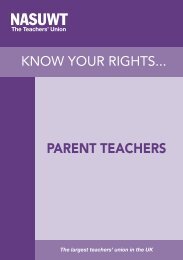
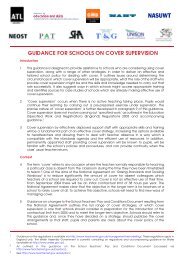
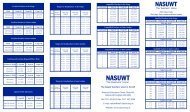
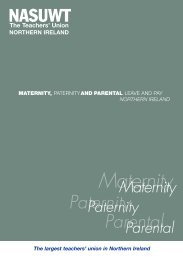
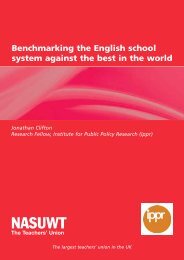
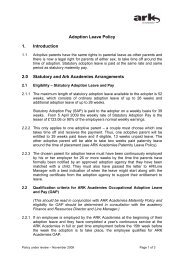


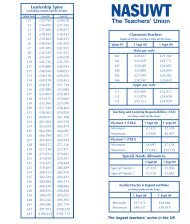

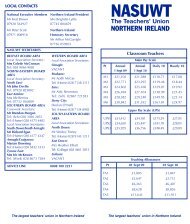
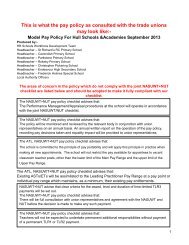
![Salaries (London & Fringe) 2012-2013 [pdf - 281 kb] - NASUWT](https://img.yumpu.com/47816007/1/190x112/salaries-london-fringe-2012-2013-pdf-281-kb-nasuwt.jpg?quality=85)